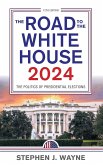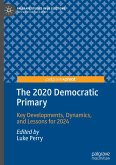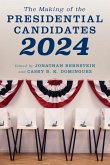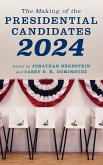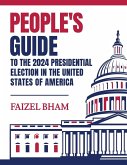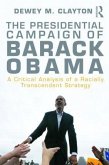- Broschiertes Buch
- Merkliste
- Auf die Merkliste
- Bewerten Bewerten
- Teilen
- Produkt teilen
- Produkterinnerung
- Produkterinnerung
This book equips students with a background on presidential elections and a guide to the 2024 election. It illustrates the strengths and weaknesses of our electoral democracy and offers insights on changes that have revolutionized contemporary electoral politics.
Andere Kunden interessierten sich auch für
![Road to the White House 2024 Road to the White House 2024]() Stephen J. WayneRoad to the White House 2024118,99 €
Stephen J. WayneRoad to the White House 2024118,99 €![The 2020 Democratic Primary The 2020 Democratic Primary]() The 2020 Democratic Primary49,99 €
The 2020 Democratic Primary49,99 €![Making of the Presidential Candidates 2024 Making of the Presidential Candidates 2024]() Making of the Presidential Candidates 202435,99 €
Making of the Presidential Candidates 202435,99 €![Making of the Presidential Candidates 2024 Making of the Presidential Candidates 2024]() Making of the Presidential Candidates 202484,99 €
Making of the Presidential Candidates 202484,99 €![The Presidential Campaign of Barack Obama The Presidential Campaign of Barack Obama]() Dewey M. ClaytonThe Presidential Campaign of Barack Obama212,99 €
Dewey M. ClaytonThe Presidential Campaign of Barack Obama212,99 €![People's Guide to the 2024 Presidential Election in the United States of America People's Guide to the 2024 Presidential Election in the United States of America]() Faizel BhamPeople's Guide to the 2024 Presidential Election in the United States of America49,99 €
Faizel BhamPeople's Guide to the 2024 Presidential Election in the United States of America49,99 €![The Presidential Campaign of Barack Obama The Presidential Campaign of Barack Obama]() Dewey M. ClaytonThe Presidential Campaign of Barack Obama58,99 €
Dewey M. ClaytonThe Presidential Campaign of Barack Obama58,99 €-
-
-
This book equips students with a background on presidential elections and a guide to the 2024 election. It illustrates the strengths and weaknesses of our electoral democracy and offers insights on changes that have revolutionized contemporary electoral politics.
Produktdetails
- Produktdetails
- Verlag: Rowman & Littlefield Publishers
- Twelfth Edition
- Seitenzahl: 296
- Erscheinungstermin: 31. Mai 2023
- Englisch
- Abmessung: 229mm x 152mm x 16mm
- Gewicht: 432g
- ISBN-13: 9781538182048
- ISBN-10: 1538182041
- Artikelnr.: 67657896
- Herstellerkennzeichnung
- Libri GmbH
- Europaallee 1
- 36244 Bad Hersfeld
- gpsr@libri.de
- Verlag: Rowman & Littlefield Publishers
- Twelfth Edition
- Seitenzahl: 296
- Erscheinungstermin: 31. Mai 2023
- Englisch
- Abmessung: 229mm x 152mm x 16mm
- Gewicht: 432g
- ISBN-13: 9781538182048
- ISBN-10: 1538182041
- Artikelnr.: 67657896
- Herstellerkennzeichnung
- Libri GmbH
- Europaallee 1
- 36244 Bad Hersfeld
- gpsr@libri.de
By Stephen J. Wayne
Part One. The Electoral ArenaChapter 1. Presidential Selection: A
Historical OverviewThe Creation of the Electoral CollegeThe Development of
Nominating SystemsCongressional CaucusesNational Nominating
ConventionsPopular Primaries and CaucusesThe Evolution of the General
ElectionPartisan ElectorsCongressional DecisionsJudicial DeterminationOther
Close ElectionsThe Politics of Electoral College VotingSummaryWhere on the
Web?ExercisesSelected ReadingsChapter 2. Campaign FinanceThe Rising Costs
of Running for PresidentThe Regulation of Campaign FinanceThe Federal
Election Campaign ActThe Buckley v. Valeo DecisionThe Soft Money Loophole
and Other AmendmentsThe Bipartisan Campaign Reform ActThe Court's Citizens
United DecisionThe Money ExplosionCandidate RevenuesFederal FundsCampaign
ExpendituresMoney and Electoral SuccessSummaryWhere on the
Web?ExercisesSelected ReadingsChapter 3. The Political
EnvironmentTurnoutThe Evolution of Voting in American ElectionsComparative
Turnout in Other CountriesInfluences on TurnoutTurnout and DemocracyTurnout
and PartisanshipThe Partisan Basis of PoliticsVoting BehaviorShifts in
PartisanshipThe Social Basis of PoliticsThe New Deal RealignmentEvolving
Political Coalitions: 1950-70Electoral Coalitions: The Last Forty
YearsSummaryWhere on the Web?ExercisesSelected ReadingsPart Two. The
NominationChapter 4. Party Rules and Their ImpactReforming the Nomination
Process: Democrats Take the InitiativeFixing the CalendarImproving
RepresentationEmpowering the LeadershipRepublican ReformsLegality of Party
RulesThe Impact of the Rule ChangesTurnoutRepresentationParty Organization
and LeadershipWinners and LosersSummaryWhere on the Web?ExercisesSelected
ReadingsChapter 5. Campaigning for the NominationBasic Strategic
GuidelinesPlan Far AheadConcentrate Efforts in the Early ContestsRaise and
Spend Big BucksGain Media AttentionDevelop an OrganizationMonitor Public
OpinionDesign and Target a Distinctive Image and MessageMake Effective Use
of Communication TechnologiesCoordinating Strategy with Candidacy
StatusCampaigning as Front-RunnerCampaigning as a
Non-Front-RunnerCampaigning as a Pulpit CandidateSummaryWhere on the
Web?ExercisesSelected ReadingsChapter 6. The Post-Primary CampaignThe
Noncompetitive Preconvention PhaseHealing Partisan DiscordRepositioning and
Reprioritizing the IssuesRepairing Leadership ImagesGaining the Stature of
an IncumbentPicking the Vice Presidential NomineePlanning for the
ConventionConvention Controversies in Historical PerspectiveContemporary
Conventions: Composition, Content, Communications, and
ImpactOratoryThemesPlatformNews Media CoverageAssessing the Conventions'
Impact on the ElectorateCharacteristics of the NomineesSummaryWhere on the
Web?ExercisesSelected ReadingsPart Three. The General Election
CampaignChapter 7. Strategy, Tactics, and OperationsThe Evolution of
Presidential CampaignsFrom Porch to TrainFrom Rally to Radio and
TelevisionFrom Art to Science: The Digital RevolutionStrategic
PlanningPartisanshipSalient IssuesLeadership ImageryDealing with
IncumbencyBuilding a Winning Electoral College CoalitionStrategic
ExecutionOrganizationThe Public DimensionField OfficesData
AnalysisSummaryWhere on the Web?ExercisesSelected ReadingsChapter 8. Media
PoliticsThe Mass Media and Electoral Politics: An OverviewPrint
MediaTelevisionThe InternetTraditional News CoverageHorse Race
JournalismNewsworthiness: Bad News Is "Good" NewsStory
LinesImpactPresidential DebatesHistoryPreparationImpactCampaign
AdvertisingFormat and ToneEmotive ContentAccuracy and TruthfulnessDigital
Communication ControversiesForeign InterferenceUse and Abuse of Personal
DataSummaryWhere on the Web?ExercisesSelected ReadingsPart Four. The
Election: Its Meaning and ConsequencesChapter 9. Understanding Presidential
ElectionsPredicting Presidential ElectionsForecasting ModelsPre-election
PollingElection-Night Reporting and Analyses of Exit PollsInterpreting the
Election ResultsModels of Voting BehaviorExplaining Presidential Election
Results: 1952-2016Converting Electoral Choice into Public PolicyThe
President's Imprecise MandateCampaign Expectations and Presidential
PerformanceTransitioning into OfficeSummaryWhere on the
Web?ExercisesSelected ReadingsChapter 10. Reforming the Electoral
SystemImproving the Selection ProcessParty RulesCampaign FinanceInforming
the ElectorateTraditional News CoverageDigital CommunicationsDemocratizing
the Road to the White HouseClosing the Participation DivideChanging the Way
Presidents Are ElectedIncreasing Competitiveness for Congressional
ElectionsSummaryWhere on the Web?ExercisesSelected ReadingsAppendix. The
2019-2020 Presidential Election Campaign
Historical OverviewThe Creation of the Electoral CollegeThe Development of
Nominating SystemsCongressional CaucusesNational Nominating
ConventionsPopular Primaries and CaucusesThe Evolution of the General
ElectionPartisan ElectorsCongressional DecisionsJudicial DeterminationOther
Close ElectionsThe Politics of Electoral College VotingSummaryWhere on the
Web?ExercisesSelected ReadingsChapter 2. Campaign FinanceThe Rising Costs
of Running for PresidentThe Regulation of Campaign FinanceThe Federal
Election Campaign ActThe Buckley v. Valeo DecisionThe Soft Money Loophole
and Other AmendmentsThe Bipartisan Campaign Reform ActThe Court's Citizens
United DecisionThe Money ExplosionCandidate RevenuesFederal FundsCampaign
ExpendituresMoney and Electoral SuccessSummaryWhere on the
Web?ExercisesSelected ReadingsChapter 3. The Political
EnvironmentTurnoutThe Evolution of Voting in American ElectionsComparative
Turnout in Other CountriesInfluences on TurnoutTurnout and DemocracyTurnout
and PartisanshipThe Partisan Basis of PoliticsVoting BehaviorShifts in
PartisanshipThe Social Basis of PoliticsThe New Deal RealignmentEvolving
Political Coalitions: 1950-70Electoral Coalitions: The Last Forty
YearsSummaryWhere on the Web?ExercisesSelected ReadingsPart Two. The
NominationChapter 4. Party Rules and Their ImpactReforming the Nomination
Process: Democrats Take the InitiativeFixing the CalendarImproving
RepresentationEmpowering the LeadershipRepublican ReformsLegality of Party
RulesThe Impact of the Rule ChangesTurnoutRepresentationParty Organization
and LeadershipWinners and LosersSummaryWhere on the Web?ExercisesSelected
ReadingsChapter 5. Campaigning for the NominationBasic Strategic
GuidelinesPlan Far AheadConcentrate Efforts in the Early ContestsRaise and
Spend Big BucksGain Media AttentionDevelop an OrganizationMonitor Public
OpinionDesign and Target a Distinctive Image and MessageMake Effective Use
of Communication TechnologiesCoordinating Strategy with Candidacy
StatusCampaigning as Front-RunnerCampaigning as a
Non-Front-RunnerCampaigning as a Pulpit CandidateSummaryWhere on the
Web?ExercisesSelected ReadingsChapter 6. The Post-Primary CampaignThe
Noncompetitive Preconvention PhaseHealing Partisan DiscordRepositioning and
Reprioritizing the IssuesRepairing Leadership ImagesGaining the Stature of
an IncumbentPicking the Vice Presidential NomineePlanning for the
ConventionConvention Controversies in Historical PerspectiveContemporary
Conventions: Composition, Content, Communications, and
ImpactOratoryThemesPlatformNews Media CoverageAssessing the Conventions'
Impact on the ElectorateCharacteristics of the NomineesSummaryWhere on the
Web?ExercisesSelected ReadingsPart Three. The General Election
CampaignChapter 7. Strategy, Tactics, and OperationsThe Evolution of
Presidential CampaignsFrom Porch to TrainFrom Rally to Radio and
TelevisionFrom Art to Science: The Digital RevolutionStrategic
PlanningPartisanshipSalient IssuesLeadership ImageryDealing with
IncumbencyBuilding a Winning Electoral College CoalitionStrategic
ExecutionOrganizationThe Public DimensionField OfficesData
AnalysisSummaryWhere on the Web?ExercisesSelected ReadingsChapter 8. Media
PoliticsThe Mass Media and Electoral Politics: An OverviewPrint
MediaTelevisionThe InternetTraditional News CoverageHorse Race
JournalismNewsworthiness: Bad News Is "Good" NewsStory
LinesImpactPresidential DebatesHistoryPreparationImpactCampaign
AdvertisingFormat and ToneEmotive ContentAccuracy and TruthfulnessDigital
Communication ControversiesForeign InterferenceUse and Abuse of Personal
DataSummaryWhere on the Web?ExercisesSelected ReadingsPart Four. The
Election: Its Meaning and ConsequencesChapter 9. Understanding Presidential
ElectionsPredicting Presidential ElectionsForecasting ModelsPre-election
PollingElection-Night Reporting and Analyses of Exit PollsInterpreting the
Election ResultsModels of Voting BehaviorExplaining Presidential Election
Results: 1952-2016Converting Electoral Choice into Public PolicyThe
President's Imprecise MandateCampaign Expectations and Presidential
PerformanceTransitioning into OfficeSummaryWhere on the
Web?ExercisesSelected ReadingsChapter 10. Reforming the Electoral
SystemImproving the Selection ProcessParty RulesCampaign FinanceInforming
the ElectorateTraditional News CoverageDigital CommunicationsDemocratizing
the Road to the White HouseClosing the Participation DivideChanging the Way
Presidents Are ElectedIncreasing Competitiveness for Congressional
ElectionsSummaryWhere on the Web?ExercisesSelected ReadingsAppendix. The
2019-2020 Presidential Election Campaign
Part One. The Electoral ArenaChapter 1. Presidential Selection: A
Historical OverviewThe Creation of the Electoral CollegeThe Development of
Nominating SystemsCongressional CaucusesNational Nominating
ConventionsPopular Primaries and CaucusesThe Evolution of the General
ElectionPartisan ElectorsCongressional DecisionsJudicial DeterminationOther
Close ElectionsThe Politics of Electoral College VotingSummaryWhere on the
Web?ExercisesSelected ReadingsChapter 2. Campaign FinanceThe Rising Costs
of Running for PresidentThe Regulation of Campaign FinanceThe Federal
Election Campaign ActThe Buckley v. Valeo DecisionThe Soft Money Loophole
and Other AmendmentsThe Bipartisan Campaign Reform ActThe Court's Citizens
United DecisionThe Money ExplosionCandidate RevenuesFederal FundsCampaign
ExpendituresMoney and Electoral SuccessSummaryWhere on the
Web?ExercisesSelected ReadingsChapter 3. The Political
EnvironmentTurnoutThe Evolution of Voting in American ElectionsComparative
Turnout in Other CountriesInfluences on TurnoutTurnout and DemocracyTurnout
and PartisanshipThe Partisan Basis of PoliticsVoting BehaviorShifts in
PartisanshipThe Social Basis of PoliticsThe New Deal RealignmentEvolving
Political Coalitions: 1950-70Electoral Coalitions: The Last Forty
YearsSummaryWhere on the Web?ExercisesSelected ReadingsPart Two. The
NominationChapter 4. Party Rules and Their ImpactReforming the Nomination
Process: Democrats Take the InitiativeFixing the CalendarImproving
RepresentationEmpowering the LeadershipRepublican ReformsLegality of Party
RulesThe Impact of the Rule ChangesTurnoutRepresentationParty Organization
and LeadershipWinners and LosersSummaryWhere on the Web?ExercisesSelected
ReadingsChapter 5. Campaigning for the NominationBasic Strategic
GuidelinesPlan Far AheadConcentrate Efforts in the Early ContestsRaise and
Spend Big BucksGain Media AttentionDevelop an OrganizationMonitor Public
OpinionDesign and Target a Distinctive Image and MessageMake Effective Use
of Communication TechnologiesCoordinating Strategy with Candidacy
StatusCampaigning as Front-RunnerCampaigning as a
Non-Front-RunnerCampaigning as a Pulpit CandidateSummaryWhere on the
Web?ExercisesSelected ReadingsChapter 6. The Post-Primary CampaignThe
Noncompetitive Preconvention PhaseHealing Partisan DiscordRepositioning and
Reprioritizing the IssuesRepairing Leadership ImagesGaining the Stature of
an IncumbentPicking the Vice Presidential NomineePlanning for the
ConventionConvention Controversies in Historical PerspectiveContemporary
Conventions: Composition, Content, Communications, and
ImpactOratoryThemesPlatformNews Media CoverageAssessing the Conventions'
Impact on the ElectorateCharacteristics of the NomineesSummaryWhere on the
Web?ExercisesSelected ReadingsPart Three. The General Election
CampaignChapter 7. Strategy, Tactics, and OperationsThe Evolution of
Presidential CampaignsFrom Porch to TrainFrom Rally to Radio and
TelevisionFrom Art to Science: The Digital RevolutionStrategic
PlanningPartisanshipSalient IssuesLeadership ImageryDealing with
IncumbencyBuilding a Winning Electoral College CoalitionStrategic
ExecutionOrganizationThe Public DimensionField OfficesData
AnalysisSummaryWhere on the Web?ExercisesSelected ReadingsChapter 8. Media
PoliticsThe Mass Media and Electoral Politics: An OverviewPrint
MediaTelevisionThe InternetTraditional News CoverageHorse Race
JournalismNewsworthiness: Bad News Is "Good" NewsStory
LinesImpactPresidential DebatesHistoryPreparationImpactCampaign
AdvertisingFormat and ToneEmotive ContentAccuracy and TruthfulnessDigital
Communication ControversiesForeign InterferenceUse and Abuse of Personal
DataSummaryWhere on the Web?ExercisesSelected ReadingsPart Four. The
Election: Its Meaning and ConsequencesChapter 9. Understanding Presidential
ElectionsPredicting Presidential ElectionsForecasting ModelsPre-election
PollingElection-Night Reporting and Analyses of Exit PollsInterpreting the
Election ResultsModels of Voting BehaviorExplaining Presidential Election
Results: 1952-2016Converting Electoral Choice into Public PolicyThe
President's Imprecise MandateCampaign Expectations and Presidential
PerformanceTransitioning into OfficeSummaryWhere on the
Web?ExercisesSelected ReadingsChapter 10. Reforming the Electoral
SystemImproving the Selection ProcessParty RulesCampaign FinanceInforming
the ElectorateTraditional News CoverageDigital CommunicationsDemocratizing
the Road to the White HouseClosing the Participation DivideChanging the Way
Presidents Are ElectedIncreasing Competitiveness for Congressional
ElectionsSummaryWhere on the Web?ExercisesSelected ReadingsAppendix. The
2019-2020 Presidential Election Campaign
Historical OverviewThe Creation of the Electoral CollegeThe Development of
Nominating SystemsCongressional CaucusesNational Nominating
ConventionsPopular Primaries and CaucusesThe Evolution of the General
ElectionPartisan ElectorsCongressional DecisionsJudicial DeterminationOther
Close ElectionsThe Politics of Electoral College VotingSummaryWhere on the
Web?ExercisesSelected ReadingsChapter 2. Campaign FinanceThe Rising Costs
of Running for PresidentThe Regulation of Campaign FinanceThe Federal
Election Campaign ActThe Buckley v. Valeo DecisionThe Soft Money Loophole
and Other AmendmentsThe Bipartisan Campaign Reform ActThe Court's Citizens
United DecisionThe Money ExplosionCandidate RevenuesFederal FundsCampaign
ExpendituresMoney and Electoral SuccessSummaryWhere on the
Web?ExercisesSelected ReadingsChapter 3. The Political
EnvironmentTurnoutThe Evolution of Voting in American ElectionsComparative
Turnout in Other CountriesInfluences on TurnoutTurnout and DemocracyTurnout
and PartisanshipThe Partisan Basis of PoliticsVoting BehaviorShifts in
PartisanshipThe Social Basis of PoliticsThe New Deal RealignmentEvolving
Political Coalitions: 1950-70Electoral Coalitions: The Last Forty
YearsSummaryWhere on the Web?ExercisesSelected ReadingsPart Two. The
NominationChapter 4. Party Rules and Their ImpactReforming the Nomination
Process: Democrats Take the InitiativeFixing the CalendarImproving
RepresentationEmpowering the LeadershipRepublican ReformsLegality of Party
RulesThe Impact of the Rule ChangesTurnoutRepresentationParty Organization
and LeadershipWinners and LosersSummaryWhere on the Web?ExercisesSelected
ReadingsChapter 5. Campaigning for the NominationBasic Strategic
GuidelinesPlan Far AheadConcentrate Efforts in the Early ContestsRaise and
Spend Big BucksGain Media AttentionDevelop an OrganizationMonitor Public
OpinionDesign and Target a Distinctive Image and MessageMake Effective Use
of Communication TechnologiesCoordinating Strategy with Candidacy
StatusCampaigning as Front-RunnerCampaigning as a
Non-Front-RunnerCampaigning as a Pulpit CandidateSummaryWhere on the
Web?ExercisesSelected ReadingsChapter 6. The Post-Primary CampaignThe
Noncompetitive Preconvention PhaseHealing Partisan DiscordRepositioning and
Reprioritizing the IssuesRepairing Leadership ImagesGaining the Stature of
an IncumbentPicking the Vice Presidential NomineePlanning for the
ConventionConvention Controversies in Historical PerspectiveContemporary
Conventions: Composition, Content, Communications, and
ImpactOratoryThemesPlatformNews Media CoverageAssessing the Conventions'
Impact on the ElectorateCharacteristics of the NomineesSummaryWhere on the
Web?ExercisesSelected ReadingsPart Three. The General Election
CampaignChapter 7. Strategy, Tactics, and OperationsThe Evolution of
Presidential CampaignsFrom Porch to TrainFrom Rally to Radio and
TelevisionFrom Art to Science: The Digital RevolutionStrategic
PlanningPartisanshipSalient IssuesLeadership ImageryDealing with
IncumbencyBuilding a Winning Electoral College CoalitionStrategic
ExecutionOrganizationThe Public DimensionField OfficesData
AnalysisSummaryWhere on the Web?ExercisesSelected ReadingsChapter 8. Media
PoliticsThe Mass Media and Electoral Politics: An OverviewPrint
MediaTelevisionThe InternetTraditional News CoverageHorse Race
JournalismNewsworthiness: Bad News Is "Good" NewsStory
LinesImpactPresidential DebatesHistoryPreparationImpactCampaign
AdvertisingFormat and ToneEmotive ContentAccuracy and TruthfulnessDigital
Communication ControversiesForeign InterferenceUse and Abuse of Personal
DataSummaryWhere on the Web?ExercisesSelected ReadingsPart Four. The
Election: Its Meaning and ConsequencesChapter 9. Understanding Presidential
ElectionsPredicting Presidential ElectionsForecasting ModelsPre-election
PollingElection-Night Reporting and Analyses of Exit PollsInterpreting the
Election ResultsModels of Voting BehaviorExplaining Presidential Election
Results: 1952-2016Converting Electoral Choice into Public PolicyThe
President's Imprecise MandateCampaign Expectations and Presidential
PerformanceTransitioning into OfficeSummaryWhere on the
Web?ExercisesSelected ReadingsChapter 10. Reforming the Electoral
SystemImproving the Selection ProcessParty RulesCampaign FinanceInforming
the ElectorateTraditional News CoverageDigital CommunicationsDemocratizing
the Road to the White HouseClosing the Participation DivideChanging the Way
Presidents Are ElectedIncreasing Competitiveness for Congressional
ElectionsSummaryWhere on the Web?ExercisesSelected ReadingsAppendix. The
2019-2020 Presidential Election Campaign



